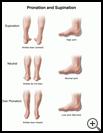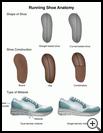
Running Shoes: Finding the Right Fit
________________________________________________________________________
KEY POINTS
- It helps to go to a store with staff that are knowledgeable about running and can help you choose the right shoes. They can advise you whether you need a shoe with cushioning, motion control, or special shoes based on where and how often you run. Also, running shoes should fit more loosely than your other shoes, so you may need a different size that you usually buy.
- Replace your shoes after 300 to 500 miles of use. They won’t absorb shock as well over time and that increases your risk for injury.
________________________________________________________________________
There are so many different makes and models of running shoes that it can be hard to find the shoes that are right for you. Everyone's feet are shaped and sized differently, so what might feel comfortable for some people feels uncomfortable for others.
It helps to go to a store with staff that are knowledgeable about running and can help you choose the right shoes.
What is my foot type?
Your foot type is based on the way you walk. Most people tend to put more of their body weight on either the inside or the outside of their foot when they walk.
If your foot leans too far to the outside when you walk, it is called over-supination. You probably over-supinate if:
- You have a tendency to walk on the outside of your foot.
- You have a high arch (even after putting weight on your foot).
- The bottoms of your shoes get more worn on the outside.
If you over-supinate, a shoe with good cushioning is important.
If your foot leans too far to the inside, it is called over-pronation. You probably over-pronate if:
- You have a low arch (when putting weight on your foot).
- Your ankle rolls inward when you walk.
- You have calluses under your big toe or ball of your foot.
- The soles of your shoes get more worn on the inside.
If you over-pronate, you might benefit from a shoe that gives more motion control and stability. A shoe that is too flexible may not give you the support that you need.
If you cannot tell if you pronate or supinate, you probably have what is called a neutral foot. You need a shoe with both cushioning and motion control.
What is the right shoe for me?
Features that you should consider when choosing a running shoe include the surface you will be running on, the shape of the shoe, the material the shoe is made from and the type of construction, and the cushioning (midsole) of the shoe.
Surface
Running shoes that are light and flexible are better for running on pavement or hard surfaces. Running shoes that have thicker outsoles give you more traction when you are running on rocky or uneven surfaces, such as nature trails.
Shape
Shoes are built either curved or straight. If you over-supinate, a curved shoe may be more comfortable for you. A straight shoe helps control inward motion. It may work well if you over-pronate.
Construction
Running shoes are made of synthetic leather, nylon, and other materials. The type of material affects the weight, breathability, waterproofing, and the overall stiffness of the shoe.
Midsole
The midsole is the base of the shoe. It provides the cushioning and shock absorption while you run. There are many different midsole materials. A midsole made of a heavy or dense material gives more stability but less cushion.
How should the shoes fit?
Your foot size changes slightly throughout the day, so it is best to try on running sneakers during the same time of day that you are most likely to run.
Running shoes should fit more loosely than your other shoes. Your feet swell when you run, and looser shoes will be more comfortable. The arch, heel, and instep should be a snug fit, but there should be a thumb-width space between your toe and the tip of your running shoe.
If you’re not sure about the best size, get the larger size. You can always wear thicker socks or use insoles. Base your decision on how the shoes feel on your feet rather than the size you usually wear.
When should I replace my running shoes?
Midsoles tend to lose their effectiveness after 300 to 500 miles of use, depending on how much you weigh and the material used in the shoe. Some runners buy 2 pairs of shoes at a time and alternate them from day to day. However, after a while the midsole loses its ability to absorb shock even if the shoes haven't been worn a lot.
Brands and styles change every year, so the model of shoe that works for you this year might not be the best shoe for you next year.


